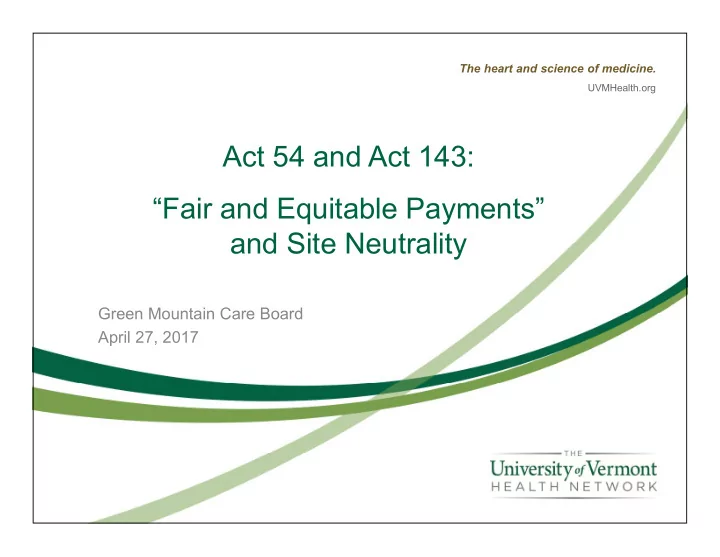

The heart and science of medicine. UVMHealth.org Act 54 and Act 143: “Fair and Equitable Payments” and Site Neutrality Green Mountain Care Board April 27, 2017
Overview • What problems are we trying to solve? • Will what has been proposed solve those problems? • Where do we go from here? 2
Problems • “Independent physicians are paid less than hospital- employed physicians” – Act 54: insurers to develop plans “for providing fair and equitable reimbursement ” • “Hospitals are buying physician practices to increase their revenues” – Act 143: GMCB to recommend whether to prohibit “provider- based billing” for practices newly transferred or acquired by hospitals 3
Fair and Equitable Reimbursement • As Vermont’s academic medical center, UVM Medical Center has a completely different cost structure than community-practice physicians – Highly-specialized services (like pediatric specialties, transplant) not otherwise available in Vermont – Level 1 Trauma Center – NICU – Education and research – 6% provider tax on physician reimbursements – Higher proportion of Medicaid, charity care and uninsured patients 4
Physician Salaries • Professional fees do not equate to physician salaries – We use several benchmarks in looking at salaries, including those for other academic medical centers as well as the Medical Group Management Association (MGMA) – Academic salaries are generally lower than non-AMC salaries – Looking just at the MGMA survey, average compensation for a UVM Medical Center-employed physician is at 30th percentile • Professional fees support the overall mission and services of the UVM Medical Center, as do all other revenues 5
“Site-Neutral Payments” • UVM Medical Center does not “buy practices” to build a larger power base – Three practices have come into the UVM Medical Center in the past 5 years – In each case, they have approached us • Why? Because practicing independently is becoming more difficult and complicated and expensive ( e.g. , needed investments in EHRs, cost of NCQA accreditation in order to be a Blueprint practice, Medicare’s new MACRA/MIPS reporting requirements) • The only payer in Vermont that uses provider-based billing is Medicare 6
We Need Facts • We continue to call on the GMCB to use the data it collects to analyze and publish meaningful and actionable facts 7
Arrowhead Health Analytics Report Source: “Health Care Costs and Cost Growth in Vermont: An Analysis of Recent Trends and Explanatory Factors,” Arrowhead Health Analytics, Sept. 2010, p.7 8
Optumus Report 9
Optumus Report 10
Optumus Report 11
Optumus Report 12
Optumus Report 13
Blueprint Data Primary Care Services Average Count of Total PMPM (Allowed = Plan and Practice Type Payer Type Age of Attributed Members Member Payments to Members Practice) COMBINED Medicare, AMC (Academic Medical Center) Medicaid, Commercial 47,032 46 $26.27 COMBINED Medicare, FQHC (Federally Qualified Health Center) Medicaid, Commercial 102,798 41 $25.62 COMBINED Medicare, Hospital-Owned Medicaid, Commercial 82,705 42 $19.41 COMBINED Medicare, Independent Multi-Site Medicaid, Commercial 23,127 24 $26.88 COMBINED Medicare, Independent Single-Site Medicaid, Commercial 76,724 40 $22.86 COMBINED Medicare, RHC (Rural Health Clinic) Medicaid, Commercial 30,594 42 $20.79 Source: Derived from “Primary Care Analysis Report – Updated 2016-12-29,” provided by GMCB to OneCare Vermont 14
Proposals • GMCB: Use MedPAC’s March 2014 recommendations for site-neutral payments – No increase in payments to newly-integrated practices for E&M codes and 66 APCs – No use of provider-based billing for those services – Make all physician practice payments consistent with MedPAC recommendations “as soon as is practicable” • Insurers: And do not let hospitals increase other revenues to offset lost revenues associated with making MedPAC-recommended changes 15
Issues • The GMCB regulates hospitals at a global level – Revenue reductions in one area will require revenue increases elsewhere • The MedPAC recommendations from 2014 were not adopted by Medicare, and are out of sync with how Medicare currently pays for those APCs – The APCs as defined in the report no longer exist (completely reconfigured in 2016) – A single APC is not a unique “service” but a group of services/CPT codes – In the last 7 years, CMS has altered the APC payment system to incorporate a significant amount of bundling/packaging methodologies, many of which would now fall under the “Group 2” category (APCs that did not meet criteria for equal payment across settings) 16
Issues • UVM Medical Center faces significantly reduced revenues should the MedPAC recommendations be implemented (if they can be) – Estimated at $13.8 million across all sites • Unless GMCB can draw a straight line between hospital revenue reductions and premium reductions – which has so far proved impossible – these changes only benefit the insurers – Hospitals’ historically-low rate increases over the past few years (1.8% in FY 2017) have not materially impacted insurance premiums (BCBSVT 2017 premium increase for VHC plans was 7.3%, MVP premium increase was 3.7%) 17
UVM Medical Center Proposals • UVM Medical Center has been lowering professional rates over the last three years • Propose to further reduce them in FY 2018 – Although will still be higher, reflecting differences in services being supported • No change in rates for any new practices integrated into UVM Medical Center starting now (site-neutrality issue) 18
How Does This Fit Into the APM? • UVM Medical Center is all-in with health care reform in Vermont – Investments in the statewide ACO that underpins the All-Payer ACO Model Agreement with CMS – Already accepting capitated payments for Medicaid lives under the Medicaid NextGen ACO Program – Ready to expand that to include Medicare and willing insurer partners in 2018 • We should be focusing on the future, and how a reformed payment system can support all providers 19
Questions? 20
Recommend
More recommend